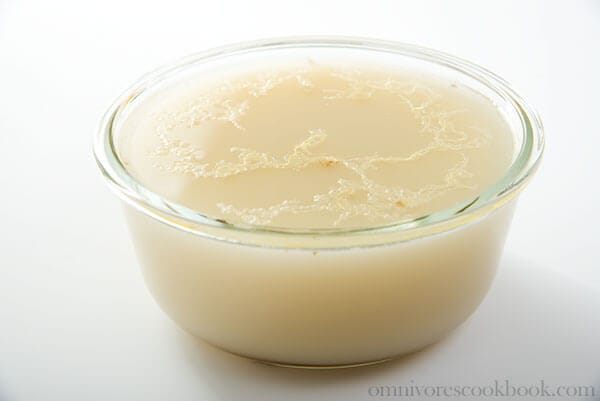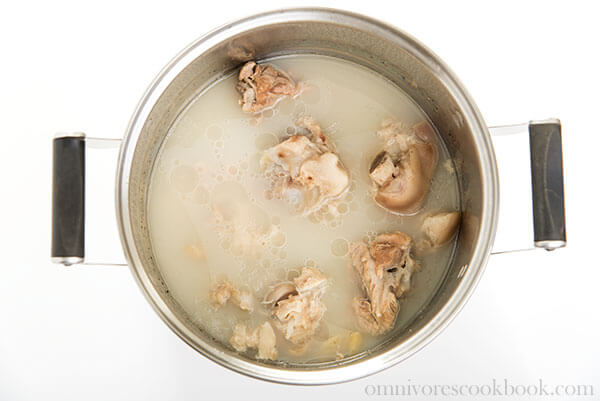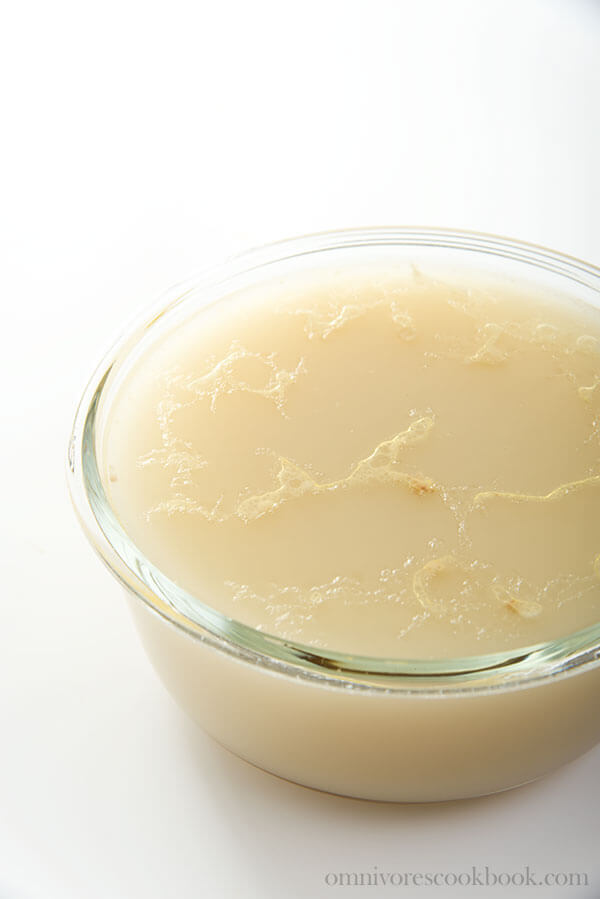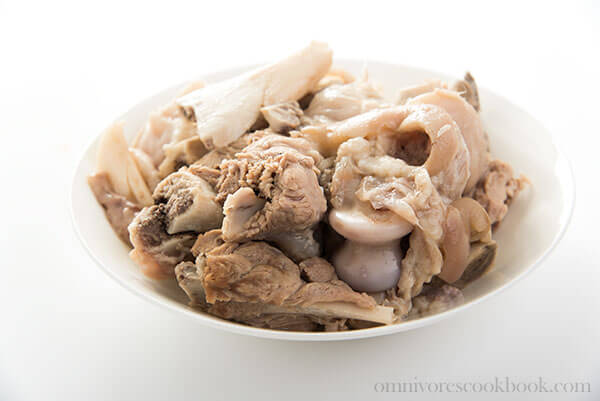
Pork stock is an essential ingredient in the Chinese kitchen, especially in the winter. It has a white semi-transparent color and a meaty taste. It can be added to all sorts of vegetable soups, noodle soups, and stews as a flavor enhancer. Compared to chicken stock, pork bones can be had at a fraction of the cost of a whole chicken, and thus provide a more economic way to make a soup base.
Soup is a necessary dish on our dinner table every day, and the same goes for millions of other Chinese families. Depending on the region, Chinese people’s eating habits toward soup vary significantly, but soup is generally considered a must-have item on people’s daily dinner tables.
In the southern part of China, people especially enjoy 煲汤 (bao tang), which is a slow cooked soup with various ingredients, including Chinese medicinal herbs. The soup usually has a superior flavor, is high in nutrients, and has a lot of health benefits.

On the other hand, people in northern China are lazier about cooking soup. Instead of cooking meat and vegetables for hours, people tend to create a quick and easy soup that only contains a few ingredients. A classic example is hot and sour soup. If you look at the ingredient list, you’ll be surprised that it uses water instead of stock as a base, to create a hyper-flavorful soup in under 20 minutes.
The other trick to creating a super simple and delicious soup is to add meat stock to the soup base. This way, you’ll only need to add a few vegetables and the soup will turn out full of flavor and satisfying.
The process of making pork stock is extremely easy. The only seasonings you’ll need are ginger and Shaoxing wine. They eliminate the unpleasant flavor of the raw pork bones without adding too much extra flavor to the soup. The aim of the boiling the bones is to create a condensed and neutral soup that you can easily use in other dishes. For this reason, pungent spices and salt are excluded from the ingredient list.

How to Create A Beautiful Pork Stock
- Use pork leg bones. They contain marrow, which adds great flavor to the stock and really makes a difference.
- Ask the butcher to chop the bones into several parts, so the bones will release flavor quickly.
- Wash the bones carefully before cooking. I don’t know about you, but I wash all meat before I cook it. Who knows where it’s been?
- Drain the soup after the first boil. This will eliminate the clotted blood and brown foam so that the stock will have a beautiful white color instead of turning brown.
- Keep the broth boiling throughout the whole cooking process. This way you’ll get a semi-transparent soup instead of a clear one.
Bonus Tips
- Enjoy the meat that falls from the bones. I added a few tips in the recipe below, so the tender meat won’t be wasted.
- Cook the second batch of broth after the first batch is finished. The second batch will be finished faster, but won’t be as dense as the first. Still, it can easily be used as a soup base to feed four people.
- Boil the soup down so it’ll be easier to store. Just remember to blend in enough water when you use the stock, so you’ll get a nice broth without consuming too many calories.
After cooking the pork stock, you can use it as a soup base and for making stew. Check out my winter melon meatball soup recipe to learn how to use pork stock!
Chinese Cooking Made Easy
Are you new to this website? This free email series is a great place to start. I’ll walk you through a few of my most popular recipes and show you how and why they work. You’ll quickly start to cook better Chinese food in your own kitchen.

Chinese Pork Stock
Ingredients
- 2 (1 kilogram / 2 pounds) pork leg bones , chopped (*see footnote 1)
- 2 tablespoons Shaoxing wine
- 1 thumb ginger
Instructions
- Wash pork bones carefully with tap water.
- Add bones, Shaoxing wine, and ginger into a large pot (or dutch oven). Add water until the pot is 4/5 full. Cover and bring to a boil. Stir the bones a few times during cooking to keep them from sticking to the bottom. Skim the foam from the surface until the soup turns clear, about 5 minutes.
- (Optional) Turn off heat. Use a pair of chopsticks (or tongs) to transfer the bones to a plate. Place a strainer over a large bowl. Strain the broth and discard bones and other fragments. Rinse the pot to get rid of any extra foam. Transfer the broth and bone backs to the pot. (*see footnote 2)
- Bring the broth to a boil again. Cover and cook over low heat (medium heat if using an electric stove) for 3.5 to 4 hours. The broth should continue boiling throughout the cooking. You don’t need to add water during the cooking, but remember to check the broth every 20 to 30 minutes. If the water runs too low and no longer covers the bones, add boiling water, 2 cups at a time. Don’t add any water during the final hour of cooking.
- At the end of cooking, the broth should be reduced to about 1/3 (or less) of the original volume. Transfer the pork stock to a bowl to cool off.
- (Optional) If the bones have any meat attached, you can separate the meat from the bones and eat it with a dipping sauce. To making the dipping sauce, combine 1 tablespoon light soy sauce with 1 teaspoon sugar. The meat will still be tender and moist and should be consumed as soon as possible. Or, you can store the meat and use it to cook fried rice later on.
- (Optional) Leave the bones in the pot and cook another batch of stock. Add water until the pot is 1/2 full. Bring the water to a boil. Cover and cook for another 2 hours to get more stock. The broth should get quite concentrated again, but won’t be as thick as the first time. You can use this broth to cook soup directly, without adding water. To store, transfer the second batch of broth to a bowl to cool off. Discard ginger and pork bones.
- You can use the stock to make soup and noodle broth and add it to stews and stir-fry dishes to enhance the flavor. If you use it to cook soup, don’t forget to add water to the stock to adjust it to taste. I used my first batch to cook four meals for two people, using the stock to cook exclusively soup.
- Wait until the stock cools off completely. You can store it in an airtight container in the fridge for up to 2 weeks, or in the freezer for up to 2 months.
Notes
- Ask the butcher to chop the pork leg bones into 3 to 4 pieces.
- The broth and pot will get very dirty the first time you bring the water to a boil. Straining the broth and rinsing the pot will help with get rid of the extra foam, so you can get clear stock in the end.
Nutrition

Did you make this recipe?
I’d love to hear how it turned out for you! Please take a moment to leave a 5-star rating ⭐️ and share your thoughts in the comments further down the page. It really helps others discover the recipe too.


ÀiLì
I made this wonderful Chinese pork stock because I am planning to make Taiwanese Dan zài noodle soup. The stock will give the dish its signature clean fresh taste. The soup was easy to make without a lot of ingredients. I thank you for giving readers this and many other great recipes so we can enjoy authentic Asian food!
Rebecca P
Hi Maggie, I love your blog and I’m enjoying the new picture of you – rockin’ it! I’m making broth for the first time ever and I followed this recipe with Belle’s suggestion about discarding the water that was first used to bring the pork bones to a boil. I then used the blanched bones with fresh water to make the broth. However the “discarded” water was in a pot for a while, to let it cool off, and I found that it had a nice aroma to it. I wondered to myself if this step is mostly just to get a broth that is clearer? ie. doesn’t look cloudy or “dirty”? Or what is the main reason for wanting to discard the broth? Also, this is my first time making broth – what does skimming off the foam do? Does the foam ruin the taste? Thanks so much!!!
Maggie Zhu
Re discarding the first boiled water – yes, the extra step gives the broth a clearer taste. We do this step back in China based on the quality of the pork bones we get. In China sometimes the meat is not properly refrigerated and the bones might have a stinky smell when you buy them. I found the bones in the US are usually pretty clean and it might not require this extra step.
The brown foam on the top of the broth is the clotted blood and impurities. It’s quite important to discard them, because they do make the broth cloudy and tastes a bit gamey.
Ken
Hi Maggie,
Question. I have made pork broth before, but I have use the neck bone. Why do you like the thigh bone better? Also I like to have Gelatin in my broth, so I am thinking about adding pigs feet to the broth. Do you get gelatin with just the thigh bone? What are your thoughts?
Maggie
Hi Ken, I posted the recipe a long time ago when I was living in China. Thigh bones are quite standard practice because they are cheap and has a good mix of pork skin, bone marrow and lean meat. The pork broth will end up quite gelatinous and the lean meat so tender and moist (we pick off the meat and eat with a dipping sauce). I think neck bone would be great as well. You can definitely add pig feet for more gelatin. Back in China my mom usually blanch pig feed separately and throw away the blanching water before using a pot of clean water for the broth, because sometime it leaves an unpleasant smell. I don’t think you have to discard the blanching water as long as the pig feet you get it very fresh.
Gen
Love this! Growing up, we used to have pork bone soups all the time, especially on colder days!
Melissa
How much water do I need to add when I reconstitute the broth? I need to get an idea of how concentrated it is. Do you think it would be about two cups of broth per one cup of water? Or would it be closer to equal parts? Thank you for this tutorial.
Maggie
Hi Melissa, I’m afraid I cannot remember the exact measurement. It really depends on how you boil down the broth, which related to the pot you use and the heat level. It’s always good to start with two cups broth per one cup of water, taste it, then adjust. It also depends on the type of soup you make. If I’m making a veggie soup, I might keep the broth a bit thin. And if I use it for ramen, I will keep the broth very thick.
Mile
Hello! I tried making this for the first time. I strained the broth in step 3 and also kept removing any foams in the soup after that but for some reason my broth turns out brownish color rather than white. It is creamy, but it is brown. I was wondering if you happen to know why this might be the case? Thank you!
Patricia
Hi! I’m super super excited to try this recipe, good home-cooked Chinese soups are something I’ve never mastered, and that I miss a lot from my childhood. My question is about the bones: I am having trouble finding pork leg bones to use from my local (western) markets. Do your have a runner-up that you can recommend in terms of cuts of pork, that might be more readily accessible at your average supermarket? Thank you! And thank you for this blog, I just discovered it a few weeks ago and have loved the few recipes I’ve tried so far.
Stuart
Hi Maggie, im making this stock now in Aus.. question, should I re add ginger and shaoxing wine after step 3? Thanks
Maggie Zhu
Yes you should add the ginger back but no need to add the wine one more time.
Sorry I replied this too late. But if you already added back the wine, it doesn’t matter that much.
Belle
The first boil is usually discarded, not strained and kept. Just too messy to strain the foam and other impurities. I would even wash the pot thoroughly. Alternatively, pour boiling water over the bones in a separate pot and soak for a bit and place the blanched and “cleaned” bones into the main pot. Among Cantonese Chinese, this is just a soup base for further processing, say, in recipes. If we make a standalone soup, we would add pork ribs, dried scallops or other dried seafood and a bit of salt for more flavor and other ingredients depending on type of soup. Examples are lotus root, winter gourd or a mix of corn, carrot and tomato.
Maggie
Hi Belle, thanks for sharing your knowledge about the Chinese pork stock! I’ll definitely add the information into the blog post 🙂
Lynda
Hi Maggie
I just completed my stock from pork bones and pork feet
I use pressure cooker to do it for 2.5 hours.
Why is the taste blend? I added shaoxing wine and ginger.
Thanks.
Maggie
Hi Lynda, I’m sorry to hear that your stock didn’t turn out well.
How much pound of pork and water did you use? If you use a pressure cooker, add just enough water to cover the bones. Because the broth won’t reduce while cooking, you will end up with bland stock if using too much water. What you can do now is to leave the bones and pork feet in, simmer uncovered for another hour (or until the stock tastes good), to reduce the stock.
Josh
Hi Maggie. Thank you for posting this. Now I know why my pork stock fails. I’ll try it your way. Just to clarify, after the first boil, the liquid should be strained and not discarded right?
Maggie
Hi Josh, yes, in the recipe the broth is strained, not discarded.
The only time I needed to discard the first batch of boiling water was when we used not-so-fresh bones, so the broth smelled a bit stinky (that’s back in China).
I hope your cooking goes well and the stock turns out delicious!
asylum01
It isn’t easy figuring out on my own things that I should have learned from my grandmother. I wanted to make my own pork stock and could only find recipes for western versions (using apple cider vinegar and such). Then I found this page. Thank you for posting this Chinese version.
I have one question: How much does the Shaoxing wine affect the flavour? The only kind I can get here is the “cooking” type, which is heavily salted to make it unsuitable for drinking. I can either use the salted wine or omit but not sure which is the better option.
Maggie
The Shaoxing wine will remove the unpleasant gamey flavor from the pork, so I consider it quite important. I think it is OK to use the salted wine here, since you only use very tiny portion of the wine to make a pot of stock. Or alternatively you can use dry sherry. It has a very similar taste and can be used in any recipe that calls for Shaoxing wine. You can find it in a liquor store.
asylum01
Thanks. I’ll use the cooking wine since it’s easier for me to get. There are two Asian supermarkets in walking distance but the liquor store requires driving.
Maggie
Happy cooking and hope the stock turns out great!
smita
Hello! I would love to make this! Could you please give a rough estimate of how much water I should start of with or better yet what the final volume of the prepared stock should be? We all have different size/shaped pots an actual measurement of the final volume to expect would help me. Loving your blog! Thank you.
Maggie
Hi Smita, I remember that pot is about 6 quart so I need to add water during the cooking. You could use a bigger one if you have one. In the end it reduces to about 8 cups. Sometimes we reduce it even more so it takes less space in the fridge. Hope this is helpful and happy cooking!
Melissa
Hey Maggie,
I’m making this right now! Do you have any Japanese ramen soupy style recipes to use the stock for?
Cheers,
Melissa
Maggie
Hi Melissa, I’m so glad to hear you’re cooking with my recipe! I have a tonkotsu ramen recipe that uses the stock: https://omnivorescookbook.com/tonkotsu-ramen/ . Hope the cooking turns out great and keep me updated on this 🙂
Patrick
Just FYI the USDA advises against washing meat before cooking. Here is a link to their site talking about why…
http://www.fsis.usda.gov/wps/portal/fsis/topics/food-safety-education/get-answers/food-safety-fact-sheets/safe-food-handling/washing-food-does-it-promote-food-safety/washing-food
I believe this habit comes from when you butchered your own animals and had to wash off feathers, dirt, ect before cooking.
Nagi@RecipeTin Eats
I love this!! Good stock is the core to any great dish and I imagine that this will be a FABULOUS base for pretty much any Chinese soup!! I am definitely giving this a go! And thank you for the tips, they are really useful, I always learn something new from you! Thanks Maggie, for taking the time to share your knowledge. 🙂
Pamela @ Brooklyn Farm Girl
I love that I just learned something new with this recipe! Perfect stock that I’ll be keeping on hand during the Winter.
Maggie
Hi Pamela, thanks for stopping by and leaving a comment! Hope you have a great holiday 🙂
mira
Hey Maggie, so glad ti see this recipe! My grandma in Bulgaria makes it in a similar way, usually around the holidays! I like it but never attempted to make ! Great pictures, I can imagine it is difficult to take pictures of this kind of jelly 🙂 Pinned!
Maggie
So agree! It is no way to take beautiful picture from these and I almost didn’t post this one because of the ugly bone photos. Thanks for sharing and have a great holiday! 🙂